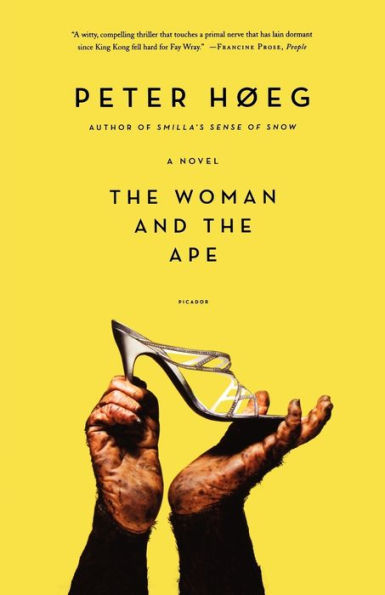

Paperback(First Edition)
-
PICK UP IN STORECheck Availability at Nearby Stores
Available within 2 business hours
Related collections and offers
Overview

Product Details
| ISBN-13: | 9780312427122 |
|---|---|
| Publisher: | Picador |
| Publication date: | 10/30/2007 |
| Edition description: | First Edition |
| Pages: | 272 |
| Product dimensions: | 5.50(w) x 8.50(h) x 0.60(d) |
About the Author
Reading Group Guide
INTRODUCTION
Madelene Burden seems an unlikely heroine.
The beautiful Danish wife of Adam, a distinguished British behavioral scientist, she is unobtrusive, acquiescent, and "nothing much really" according to her father. Spending each day like her last, she perfects her make-up and wanders the grounds of her colonialist in-laws' vast manor, not-so-slowly drinking herself numb off a homemade concoction of 99.6% ethyl alcohol and water.
Erasmus seems an unlikely romantic lead.
Weighing in at a hefty 300 pounds, he is hairy, lice-infested, and just so happens to be an ape. Victim of a botched animal-smuggling attempt, Erasmus is believed to be "a new and hitherto unknown mammal, an apparently highly intelligent anthropoid ape." Adam Burden and his calculating sister Andrea (who, ironically, heads up London's Animal Welfare Foundation) anticipate the opportunity of a lifetime by introducing this new species to the world. Certainly this will ensure Adam's appointment to the directorship of the New London Regent's Park Zoological Garden, soon to be the world's most powerful animal institution.
Seeing in Erasmus a kindred spirit, Madelene realizes that "she too was an ape, for, while she might well be able to leave this cage, and this house, she would not get very far before running up against the financial, social and marital barriers that circumscribed her life." Enlisting the aid of the still-befuddled smugglers, Madeline and Erasmus make a daring and dramatic escape over the balconies and rooftops of London to the Edenic rural game preserve of St. Francis Forest, where Madelene explores her "animal" side and Erasmus his "human." Over the course of the next few weeks the unlikely pair experience each other physically and mentally, eventually fall in love, and plot their next move.
Madelene and Erasmus can only keep the outside world at bay for so long. Towards the novel's conclusion, we learn that Erasmus has come to England with a purpose after all, and much like the scores of animal activists, zoologists, journalists, and police who are trying to hunt the couple down, he too has a hidden agenda – one which affects not only Erasmus and his "people" but Madelene, a society's conscience, and the entire human race as well.
The Woman and the Ape is Danish author Peter Hoeg's fourth novel. His works prior to this include Borderliners, The History of Danish Dreams, and the critically acclaimed, internationally successful thriller Smilla's Sense of Snow. Keeping close to his roots, he currently resides in Copenhagen with his wife and two daughters.
DISCUSSION QUESTIONS
- Erasmus informs Madelene that where he comes from, his kind are called "people" and hers "animals." In what ways throughout the book does Hoeg project the notion that animals are more like people and people more like animals?
- Madelene comes from Denmark, where the "very atmosphere was crystalline and under constant threat of shattering and no voice was ever raised above a whisper for fear of starting an avalanche." In what ways are Erasmus and Madelene more similar than different? Do you feel they are held together more by their commonalities or differences? What do you think Hoeg is saying about the relationship between humans and animals?
- Discuss Madelene's "resurrection" every morning. Why is it necessary? How is this resurrection different by the end of the book?
- When the public learned that Erasmus was not the only highly intelligent talking ape in their midst, "the nation froze and ground to a halt. Every visible human activity ceased, even crime came to a standstill, paralyzed by a fear greater than greed." How do you account for that kind of reaction?
- Describe instances, images, and/or metaphors throughout the book in which Hoeg expresses feelings of confinement and captivity.
- Where do you find Hoeg's images of civilization and paradise? Is it possible for the two to coexist?
- Near the end of the novel, Dr. Bowen confides that, according to Erasmus' DNA analysis, "We had it all wrong. Burden, his sister and I. We thought we would learn something about one of those hominids which came before man. But you are not what went before. If anything, you are what comes afterward." What do you think Hoeg is saying about human evolution?
- In the novel, the scientific world of animal research is portrayed as cruel, exploitative, and tortuous. Where does thirst for knowledge end and brutality towards animals begin? When, if at all, can zoological institutions be justified? Can animal research for human "well being" be justified?
Smilla's Sense of Snow



